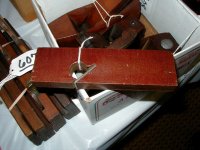To add some details to Tim's good advise, you may want to consider the pitch (cutting angle) of the molding planes you buy. There are four standard pitches. Common (45?), York (50?), Middle (55?), and Half (60?). Old American planes are most commonly found in common pitch, whereas it is easier to find English planes in higher pitches. Higher pitch planes work better in hardwoods, especially figured hardwoods, but are a bit harder to push, and may need sharpening more often.
Hollows and rounds and unfenced rabbet planes can be used in either direction, to address grain reversals. Snipes-bill and side rounds are made and sold in pairs, for the same reason. Complex molding profiles only work in one direction (right handed, with your bench and sticking board on your right, your right hand on the top of the plane, and your left hand on the side. For this reason, a higher pitch or rigorous wood selection criteria are important for a complex molder.
The main disadvantage of cherry is that it will not wear as well as beech, but for amount of most of the work most of us do, that is not important. If the planes were to be used in a production environment, making architectural moldings day in and day out, boxed planes (with boxwood wear strips) would be an advantage, but the boxing may require maintenance, especially on old planes.

